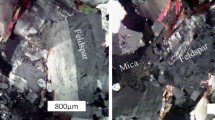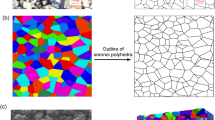Abstract
A series of laboratory tests were carried out focusing on the fracture characteristics of granite under different stress conditions. The macroscopic mechanical characteristics of granite, such as nonlinear stress–strain curve, tension compression bi-modularity, crack initiation, and propagation laws during Brazil splitting, were analyzed with the help of the digital image correlation method. A fine discrete-element model was established based on the laboratory test results and aimed to overcome the shortcomings of traditional simulation. The proposed model reproduced the characteristics of inherent microcrack closure, tension compression bi-modularity, and crack evolution under different stress paths. The detailed calibration method of the microparameters in the model was summarized. The relationship between macro-mechanical properties and micro-attributes of granite was further analyzed using the fine discrete-element model. The stress thresholds in uniaxial compression and crack initiation phenomenon in Brazil splitting were analyzed and explained from the micro-perspective. The microphysical significance of the Hoek–Brown criterion in shear failure was clarified through analyzing numerical test results. Hoek–Brown criterion is found being a statistical rule summary of the overall strength composed of the random distribution of the strength of the two parts in the rock: the cohesion of bonded particles and the friction of nonbonded particles.
Highlights
-
A comprehensive discrete-element model is established that can simultaneously reflect the characteristics of inherent microcrack closure, tension compression bi-modularity and crack evolution under different stress paths.
-
The stress thresholds in uniaxial compression and the crack initiation phenomenon in Brazil splitting are analyzed and explained from the micro-perspective.
-
The microphysical significance of Hoek–Brown criterion is clarified through numerical tests.



















Similar content being viewed by others
Data availability
The authors confirm that the main data supporting the findings of this study are available within the article. Some basic programming methods are available on request from the corresponding author, Cheng Zhao, upon reasonable request.
References
Akesson U (2008) Characterisation of micro cracks caused by core-disking. CBI Swed Cem Con Res Ins. www.skb.se
Bahaaddini M, Sheikhpourkhani AM, Mansouri H (2019) Flat-joint model to reproduce the mechanical behaviour of intact rocks. Eur J Env Civ Eng. https://doi.org/10.1080/19648189.2019.1579759
Benson PM, Vinciguerra S, Meredith PG, Young RP (2008) Laboratory simulation of volcano seismicity. Sci. https://doi.org/10.1126/science.1161927
Blaber J, Adair B, Antoniou A (2015) Ncorr: open-source 2D digital image correlation matlab software. Exper Mech. https://doi.org/10.1007/s11340-015-0009-1
Chen PY (2017) Effects of microparameters on macroparameters of flat-jointed bonded-particle materials and suggestions on trial-and-error method. Geotech Geo Eng. https://doi.org/10.1007/s10706-016-0132-5
Ding XB, Zhang LY (2014) A new contact model to improve the simulated ratio of unconfined compressive strength to tensile strength in bonded particle models. Int J Roc Mech Min Sci. https://doi.org/10.1016/j.ijrmms.2014.03.008
He M, Zhang Z, Zheng J, Chen F, Li N (2020) A new perspective on the constant mi of the Hoek–Brown failure criterion and a new model for determining the residual strength of rock. Roc Mec Roc Eng 53(9):3953–3967. https://doi.org/10.1007/s00603-020-02164-6
Hoek E, Brown ET (1980) Empirical strength criterion for rock masses. J Geotech Eng Div. https://doi.org/10.1061/AJGEB6.0001029
Hoek E, Martin CD (2014) Fracture initiation and propagation in intact rock—a review. J Roc Mech Geotech Eng. https://doi.org/10.1016/j.jrmge.2014.06.001
Holt RM, Kjølaas J, Larsen I, Li L, Pillitteri AG, Sønstebø EF (2005) Comparison between controlled laboratory experiments and discrete particle simulations of the mechanical behaviour of rock. Int J Roc Mech Min Sci. https://doi.org/10.1016/j.ijrmms.2005.05.006
Hondros G (1959) The evaluation of Poisson’s ratio and the modulus of materials of a low tensile resistance by the Brazilian (indirect tensile) test with particular reference to concrete. Aus J App Sci 10(3):243–268
International Society for Rock Mechanics (1978) Suggested methods for determining tensile strength of rock materials. Int J R Mec MinSci 3(15):99–103
Kazerani T (2013) Effect of micromechanical parameters of microstructure on compressive and tensile failure process of rock. Int J Roc Mech Min Sci. https://doi.org/10.1016/j.ijrmms.2013.08.016
Kazerani T, Zhao J (2010) Micromechanical parameters in bonded particle method for modelling of brittle material failure. Int J Numer Anal Met Geomech. https://doi.org/10.1002/nag.884
Li Z, Rao QH (2021) Quantitative determination of PFC3D microscopic parameters. J Cen Sou Univ 28(3):911–925. https://doi.org/10.1007/s11771-021-4653-6
Li KH, Cheng YM, Fan X (2018) Roles of model size and particle size distribution on macro-mechanical properties of Lac du Bonnet granite using flat-joint model. Comp Geotech. https://doi.org/10.1016/j.compgeo.2018.07.007
Lisjak A, Grasselli G (2014) A review of discrete modeling techniques for fracturing processes in discontinuous rock masses. J Rock Mech Geotech Eng. https://doi.org/10.1016/j.jrmge.2013.12.007
Lockner D, Byerlee JD, Kuksenko V, Ponomarev A, Sidorin A (1991) Quasi-static fault growth and shear fracture energy in granite. Nature. https://doi.org/10.1038/350039a0
Martin CD, Chandler NA (1994) The progressive fracture of Lac du Bonnet granite. Int J Roc Mech Min Sci. https://doi.org/10.1016/0148-9062(94)90005-1
Potyondy DO, Cundall PA (2004) A bonded-particle model for rock. Int J Roc Mech Min Sci. https://doi.org/10.1016/j.ijrmms.2004.09.011
Potyondy DO (2012) A Flat-Jointed Bonded-Particle Material for Hard Rock, 46th US Rock Mechanics/Geomechanics Symposium 2012: Chicago, IL, USA
Potyondy DO (2018) A Flat-Jointed bonded-particle model for rock, 52nd U.S. Rock Mechanics/Geomechanics Symposium. 2018, American Rock Mechanics Association: Seattle, Washington, USA
Shu B, Liang M, Zhang S, Dick J (2019) Numerical modeling of the relationship between mechanical properties of granite and microparameters of the flat-joint model considering particle size distribution. Math Geosci. https://doi.org/10.1007/s11004-018-09780-7
Stacey TR (1981) A simple extension strain criterion for fracture of brittle rock. Int J Roc Mech Min Sci. https://doi.org/10.1016/0148-9062(81)90511-8
Vallejos JA, Salinas JM, Delonca A, Mas Ivars D (2017) Calibration and verification of two bonded-particle models for simulation of intact rock behavior. Int J Geomech. https://doi.org/10.1061/(ASCE)GM.1943-5622.0000773
Wen T, Tang H, Ma J, Wang Y (2018) Evaluation of methods for determining crack initiation stress under compression. Eng Geol. https://doi.org/10.1016/j.enggeo.2018.01.018
Weng MC, Li HH (2012) Relationship between the deformation characteristics and microscopic properties of sandstone explored by the bonded-particle model. Int J Rock Mech Min Sci. https://doi.org/10.1016/j.ijrmms.2012.07.003
Wu SC, Xu XL (2015) A study of three intrinsic problems of the classic discrete element method using flat-joint model. Roc Mech Roc Eng. https://doi.org/10.1007/s00603-015-0890-z
Xu XL, Wu S, Gao Y, Xu M (2016) Effects of Micro-structure and Micro-parameters on Brazilian Tensile Strength Using Flat-Joint Model. Roc Mech Roc Eng. https://doi.org/10.1007/s00603-016-1021-1
Yang SQ, Huang YH (2014) Particle flow study on strength and meso-mechanism of Brazilian splitting test for jointed rock mass. Act Mech Sin. https://doi.org/10.1007/s10409-014-0076-z
Yin PF (2019) Yang SQ (2019) Discrete element modeling of strength and failure behavior of transversely isotropic rock under uniaxial compression. J Geo Soc Ind 93(2):235–246. https://doi.org/10.1007/s12594-019-1158-0
Zhang XP, Wong LYN (2011) Cracking processes in rock-like material containing a single flaw under uniaxial compression: a numerical study based on parallel bonded-particle model approach. Roc Mech Roc Eng. https://doi.org/10.1007/s00603-011-0176-z
Zhang BY, Zhang CS, Wang CL, Hao BQ (2021a) Calibration method of meso-parameters of PFC2D Flat-Joint model. Chin J Comp Mech. https://doi.org/10.7511/jslx20200722002
Zhang R, Zhao C, Yang C, Xing J, Morita C (2021b) A comprehensive study of single-flawed granite hydraulically fracturing with laboratory experiments and flat-jointed bonded particle modeling. Comp Geotech. https://doi.org/10.1016/j.compgeo.2021.104440
Zhao C, Xing J, Zhou Y, Shi Z, Wang G (2020) Experimental investigation on hydraulic fracturing of granite specimens with double flaws based on DIC. Eng Geol. https://doi.org/10.1016/j.enggeo.2020.105510
Zhao C, Zhang R, Zhang Q, Du S, Yang C (2022) Experimental study on the rift plane of granite under uniaxial compression. J App Geo. https://doi.org/10.1016/j.jappgeo.2022.104590
Acknowledgements
This work was supported by the National Natural Science Foundation of China [Grant numbers U22A20597, 42142019]. The authors are deeply grateful for these supports. The anonymous reviewers’ comments have improved the quality of this paper and are also greatly acknowledged.
Author information
Authors and Affiliations
Contributions
Conceptualization: CZ, RZ; methodology: RZ, JN, JX; formal analysis and investigation: RZ, JX, QL; writing—original draft preparation: RZ; writing—review and editing: RZ, CZ, YH; funding acquisition: CZ; resources: CZ; supervision: CZ.
Corresponding author
Ethics declarations
Conflict of Interest
The authors declare that they have no known competing financial interests or personal relationships that could have appeared to influence the work reported in this paper.
Additional information
Publisher's Note
Springer Nature remains neutral with regard to jurisdictional claims in published maps and institutional affiliations.
Rights and permissions
Springer Nature or its licensor (e.g. a society or other partner) holds exclusive rights to this article under a publishing agreement with the author(s) or other rightsholder(s); author self-archiving of the accepted manuscript version of this article is solely governed by the terms of such publishing agreement and applicable law.
About this article
Cite this article
Zhang, R., Zhao, C., Xing, J. et al. A Study on Mechanical Behavior of Intact Granite Through a Sound Simulation Using Flat-Jointed Contact. Rock Mech Rock Eng 57, 1417–1436 (2024). https://doi.org/10.1007/s00603-023-03612-9
Received:
Accepted:
Published:
Issue Date:
DOI: https://doi.org/10.1007/s00603-023-03612-9




